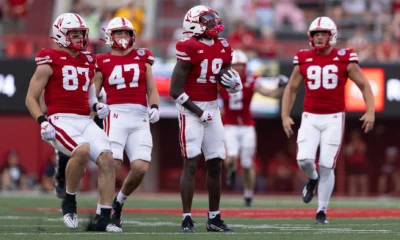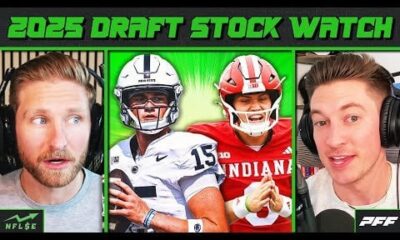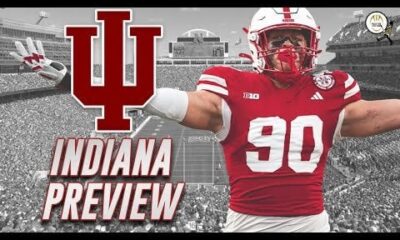What makes a 5 Star player different from a 4 star or a 3 star? How do the sites determine these. Well, I don't know *all* of the answers, I'm just an average Redditor, but I'm going to try my best to explain these how I understand them.
The first thing to understand is there are four major recruit ranking websites right now. 247Sports, Rivals, On3 and ESPN. Each of these sites employe a number of scouts and evaluators who will watch thousands of recruits film and give them a prospect grade. Every site has a different ranking system. On3 and 247Sports give a grade out of 100 (A recruit with a 100 grade in their system is considered a "perfect" prospect, but they are weird and sometimes give out 101 grades as well). ESPN also uses a scale that maxes out at 100, but they tend to be much more conservative with their rankings, and their star ranges reflect that. Rivals tops out their grades at 6.1 as far as I can tell.
There's no site that gets perfect rankings, and some of the misses can be bad. For instance, 247 Sports gave DJ U a 101 grade, or grading Brock Vandagriff and Tyler Buchner over Jalen Milroe. At the end of the day, these grades are the reflections of opinions of scouts. Sometimes they'll give a blurb and a comparison, or sometimes (like with On3) they'll drop a player from top 10 to 74 without giving an explanation and there being no noticeable drop off in the quality of their play. (And yes I am referring to Dylan with that one).
Star grades an artificial representation of those rankings, for the most part.
On3 and 247Sports use the following scale:
97+ is a 5 Star Recruit
90-96 is a 4 Star Recruit
80-89 is a 3 Star Recruit
70-79 is a 2 Star Recruit
\(We don't usually see recruits lower than 2 stars ranked at all).*
As I mentioned earlier, ESPN is more conservative with their grades, so they use the following scale:
90+ is a 5 Star
80-89 is a 4 Star
70-79 is a 3 Star
60-69 is a 2 Star
Rivals has a much more narrow range in their ratings
6.1 is a 5 Star
5.8 – 6.0 is a 4 Star
5.5 – 5.7 is a 3 Star
5.2 – 5.4 is a 2 Star
In my experience, these are usually what the star ranges are supposed to represent:
5 Stars – Elite Prospects. If their development in College goes correctly, these guys are projected to be First Round picks in the NFL in a few years. They can sometimes start for a team right away and instantly make an impact. We are seeing that a lot this year with players like Dylan, Ryan Williams, Jeremiah Smith, and Dylan Stewart.
4 Stars – Four Star players often have the high end talent that the five stars have, but they aren't quite as perfect of prospects for whatever reason. Make no mistake though, they're serious talents and can contribute to a team right away. Or maybe they need a bit more development time. Keeping with my Metaphor of NFL draft picks, these guys are 2nd Round picks at the high end, or 3rd round picks at the low end.
3 Stars – These players usually lack the elite talent that the 4 and 5 Stars have, so they often need more development time before they're ready to continue at a high level. The majority of players at the Power Five level are 3 Star Players. The "Projection" for a 3 star player is that they usually redshirt and sit for a few years before becoming a starer, and then they'll usually wind up as a solid contributor who is picked on Day 3 of the NFL draft (Rounds 4-7). Kirk Cousins is a prime example. He signed to Michigan State as a 3 Star QB and redshirted, before taking over as starter in his third year, and he had a solid career with them before being chosen in the 4th round by Washington.
2 Stars – It's very rare to see 2 Star recruits playing on Power 4 teams. There's usually more fundamental flaws to their game and/or a lack of athleticism that will prevent them from competing at the higher level, but they might still have a solid college football career at either a G6 or FCS program, or as a walk-on at a Power 4 school.
Keep in mind too, there are THOUSANDS of College Football prospects. It's almost impossible for these sites to keep up and rank everybody, so sometimes players who are unranked at the time will commit to certain teams. Sometimes if that happens, the sites will give a default ranking. For instance, if Rivals has not yet ranked a player who signs with an FBS team, they'll give them a default ranking of 3 Stars.
And I cannot state these enough, these rankings can often have very WILD swings. For instance, Shea Patterson was the #1 QB in the 2016 Class, ahead of players like Jalen Hurts, Dwayne Haskins (Both 4 stars) and Justin Herbert (3 stars). Arguably the two best QBs in the NFL right now, Patrick Mahomes and Josh Allen, were both 3 stars. Suh was a high 4 star and was arguably the greatest defensive player in the history of college football, but we've had a lot of 4 star busts in the past like Alante Brown or Patrick O'Brian.
These services will often disagree with each other about certain players. Take for example Cam Lenhardt. 247Sports and On3 have him as a high 3 star, while Rivals and ESPN had him as a 4 star. Going back to Dylan, even though he was downgraded from the perfect 100 grade he was at early in his recruiting process, he was still a consensus 5 Star QB… except for On3, who downgraded him to a 4 star for reasons that are still unclear.
This is partially why I prefer composite rankings, especially at the end of the recruiting process. Composite rankings are an aggregate of all of the major services, and they'll usually tell you what the "consensus" ranking on a player is. Using my two examples above, the grades on Lenhardt averaged out to a 4 star, while for Dylan he was still firmly as a 5 Star even though On3 downgraded him in their personal rankings. (On3 also shows their Industry Composite in a higher priority than their own personal rankings, which is interesting.)
Does this mean that recruiting rankings 're a complete crapshoot and should be disregarded entirely? Absolutely not. For instance, Jadeveon Clowney was considered by many to be the best prospect ever (247 Sports went as far as to give him a 105 grade, which I believe is their highest ever) and he had a dominant college career and was picked #1 in the NFL draft. Trevor Lawrence and Justin Fields were both 101 graded prospects in 2018. They both had dominant College Careers and were first round picks, and appear to generally be by far and away the best two QBs from that class. There's also the matter of the "Blue Chip Ratio".
4 and 5 Star players are considered "Blue Chip" prospects. There's no formal definition of "Blue Chip" but they're considered players with Elite Talent that can usually have an impact right away. The last thirteen National Champions have had rosters comprised of majority Blue Chip recruits. The three lowest being 2016 Clemson at 52%, 2013 Florida State at 53% and 2024 Michigan at 54%.
Overall, scouting is a complicated and deeply flawed profession. At any level, scouts are going to have big hits and massive misses, but they usually have good reasons for thinking the things they do. They do this for a living and look at thousands of prospects. At the end of the day though, I think CBS says it best in their article about the Blue Chip Ratio. This isn't a substitute for proper coaching and development. Many coaches have been great recruits or signed highly ranked classes that never panned out (Cough cough Jimbo Fisher, Frost's staff also had a high miss rate on 4 Stars).

Must See
-


Football
/ 5 months agoHuskers Fight Hard but Fall Short Against UCLA
LINCOLN – The Nebraska Cornhuskers gave it their all on Saturday, with standout efforts...
-


Football
/ 6 months agoGAMEDAY: Nebraska Set to Face Undefeated Indiana in Key Big Ten Showdown
Bloomington, IN – It’s Game Day, Husker Nation! Nebraska (5-1, 2-1 Big Ten) returns...
-


Football
/ 6 months agoBlackshirts Shine as Nebraska Tops Rutgers 14-7 on Homecoming
Lincoln, NE – Nebraska’s Blackshirt defense played a starring role in the Huskers’ 14-7...
By Chris













You must be logged in to post a comment Login